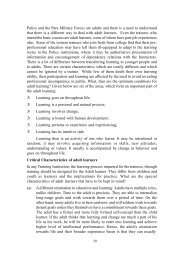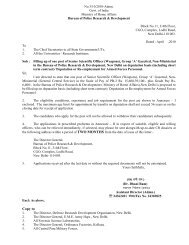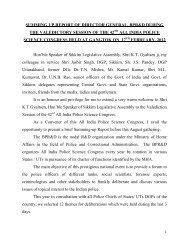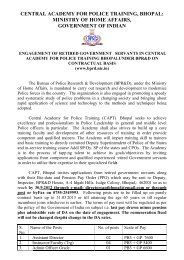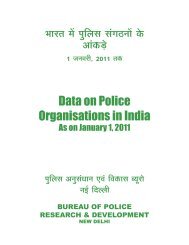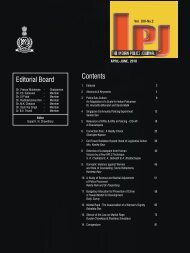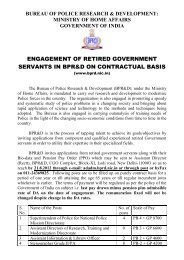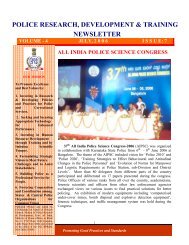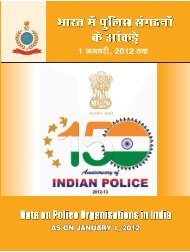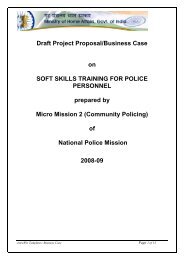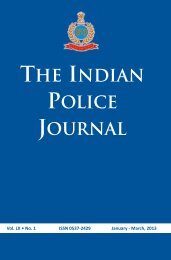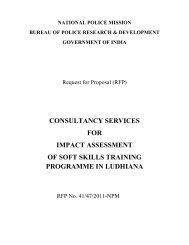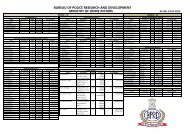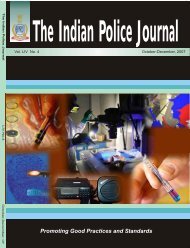unseemly rivalry, separate Detective Departmentfor Calcutta <strong>Police</strong> was created in 1909, <strong>and</strong> aseparate Special Branch, in 1911. To differentiatethe Bengal Special Branch from its Calcuttacounterpart, it was named as IntelligenceBranch.The Provincial Special Branches had to improvetheir collection <strong>and</strong> processing <strong>of</strong> intelligence inthe face <strong>of</strong> growing terrorist activities. Though,both the Central <strong>and</strong> Provincial intelligence usedto work together, <strong>of</strong>ten the Central Intelligenceworked as an umbrella agency for the ProvincialBranches. Between 1908 <strong>and</strong> 1916, there was aspate <strong>of</strong> dacoities <strong>and</strong> assassination <strong>of</strong> lower levelintelligence <strong>and</strong> CID <strong>of</strong>ficers in Bengal, leadingto a crisis <strong>of</strong> morale <strong>and</strong> efficiency, as the Indian<strong>of</strong>ficer declined to work in these organisations.Both, Home Member, Reginald Craddock <strong>and</strong>Director <strong>of</strong> Central Intelligence (DCI), CharlesClevel<strong>and</strong>, were seriously concerned <strong>and</strong>extended full support to the Indian <strong>of</strong>ficers“who have been murdered, ostracized <strong>and</strong>threatened.” 29Reginald Craddock expressed similar concerns<strong>and</strong> condemned the terrorists for “murderinginformers <strong>and</strong> zealous Criminal InvestigationDepartment <strong>of</strong>ficers, supplemented by murder<strong>of</strong> school masters who have faithfully done theirbest to suppress sedition under their charge.” 30With the moral support <strong>and</strong> material assistance<strong>of</strong> the Central Intelligence, <strong>and</strong> under theinspiring leadership <strong>of</strong> Charles Tegart, DIG <strong>of</strong> theIntelligence Branch, the morale <strong>and</strong> efficiency <strong>of</strong>the organization was restored.When the Central Intelligence was under severestress, the Special Branches <strong>and</strong> the CIDsacted in a body to face the situation. On 23rdDecember,1912 Viceroy Hardinge narrowlyescaped death in the bomb attack in Delhi.The intelligence had no information about theexistence <strong>of</strong> any secret society in North India. TheCentral Intelligence <strong>and</strong> its Director, Clevel<strong>and</strong>,came under severe attack for failure to prevent29 Notes in the CIB, dated 4 February, 1916. Quoted by RichardPopplewell, in Intelligence <strong>and</strong> Imperial Defence, P20930 Memor<strong>and</strong>um <strong>of</strong> R.H.Craddock dated 26 February, 1916..Quoted by Popplewell, op..cit. P 208 Craddock referred tothe murder <strong>of</strong> the Headmaster <strong>of</strong> Comilla High School onMarch,4,1915 <strong>and</strong> the Murder <strong>of</strong> Headmaster Maldah ZillaSchool on January25,1916 by the revolutionary terrorists.the outrage. As the normal investigation failed toproduce any result <strong>and</strong> the pressure on Clevel<strong>and</strong>increased, a special team was formed under DavidPetrie, with 34 Intelligence <strong>and</strong> CID <strong>of</strong>ficersfrom Punjab, UP, Bengal, Bombay <strong>and</strong> CentralProvinces. Petrie claimed that by March 1913,there was “scarcely a single person all over Indiacapable <strong>of</strong> being considered as a potential factorin the bomb conspiracy, whose doings have notbeen subjected to careful scrutiny.” 31 When thisteam also failed to show any positive result, evenafter ten months, the Viceroy’s Executive Councilpassed a formal vote <strong>of</strong> censure on Clevel<strong>and</strong>.On Harcourt Butler’s advice, Clevel<strong>and</strong>consulted Sir Edward Henry 32 , Commissioner,Metropolitan <strong>Police</strong>, London for lending English<strong>and</strong> French detectives. But Henry, pointingout the constraints <strong>of</strong> geography, language <strong>and</strong>people for foreign detectives, advised that thelocal detective talents in India were superior toEnglish detectives. It was really embarrassing thatone <strong>of</strong> the most comprehensive investigationsever launched in India, failed to trace the culprit.Then, after about 14 months, Denham <strong>of</strong> theSpecial Team <strong>and</strong> Tegart <strong>of</strong> Bengal Intelligencesucceeded in identifying the revolutionary groupfrom the remnants <strong>of</strong> the bombs which explodedin Sylhet, Calcutta, Lahore <strong>and</strong> Delhi <strong>and</strong> froma revolutionary leaflet printed in Calcutta <strong>and</strong>circulated in the Punjab <strong>and</strong> UP. All the culpritswere brought to book, except Rash Behari Bose,who could never be arrested. Thereafter, theSecret Service grant <strong>of</strong> the DCI was doubled from50 thous<strong>and</strong> rupees to one lakh rupees.The Government having appreciated theusefulness <strong>of</strong> the intelligence agencies incontaining revolutionary terrorism, especially inBengal, readily sanctioned the creation <strong>of</strong> DistrictIntelligence Branches in every district <strong>of</strong> Bengalin 1917, bringing all important localities <strong>and</strong>endemic areas under intelligence scanner.31 D.Petrie’s note on the investigation <strong>of</strong> the Delhi Bomb Case.32 Sir Edward Henry was Inspector General <strong>of</strong> <strong>Police</strong>, Bengal.While he was district magistrate, Hooghly in the last decade<strong>of</strong> the 19th century, two <strong>of</strong> his subordinate <strong>of</strong>ficer namelyHem Ch<strong>and</strong>ra Basu <strong>and</strong> developed the system <strong>of</strong> study <strong>of</strong>finger print for identification. The system was tested <strong>and</strong>found to be scientific <strong>and</strong> has since been adopted all overthe world as the most scientific method <strong>of</strong> identification.Though developed by an Indian, the system has been namedas Henry’s System.16The Indian <strong>Police</strong> Journal, October - December, 2012, Special Issue
The agency more <strong>and</strong> more fine-tuned theirtrade-craft by adopting still more rigorous system<strong>of</strong> recruitment <strong>and</strong> screening <strong>of</strong> the sources <strong>and</strong>keeping them under deep cover. 33 Armed withwide knowledge about the terrorists <strong>and</strong> theiroutfits, they acquired the ability to influence thegroups <strong>and</strong> even engineer a split in the group.Thus, the agencies emerged not only as the mostpowerful instruments against the undergroundmovement, but also as advisors to theGovernment in formulating the policy towardsthe revolutionary movement, in particular <strong>and</strong>the political movement, in general.The growing influence <strong>of</strong> the Intelligence <strong>and</strong>the <strong>Police</strong> on the formulation <strong>of</strong> the Governmentpolicy was criticized not only at the political levelin Engl<strong>and</strong> but also in the bureaucratic circles, forturning India into a “<strong>Police</strong> state”. In January,1918,Secretary <strong>of</strong> State Montague wrote to ViceroyChelmsford, “I have an uneasy feeling that theCID is being used not merely as a great detectiveagency, but as an instrument <strong>of</strong> Government: thatits activities are too widespread; that it is growingtoo rapidly; that it is convenient but dangerousto govern by means <strong>of</strong> your police.” Among theIndians, the only significant voice <strong>of</strong> protest camefrom Rabindranath Tagore, who in 1917 madea scathing criticism <strong>of</strong> the Government, police<strong>and</strong> intelligence in an article, “The Small <strong>and</strong> theGreat” 34 , read out to hundreds <strong>of</strong> people beforepublication.The Government’s decision to enact a newlegislation (Rowlatt Act), to take the place <strong>of</strong> theDefense <strong>of</strong> India Act,1915, which would lapseafter the World War, was the result <strong>of</strong> persistentprodding by the Central Intelligence <strong>and</strong> theIntelligence Branch, Bengal. Two intelligence<strong>of</strong>ficers namely J.C.Ker, Personal Assistant tothe Director <strong>of</strong> Central Criminal Intelligence33 Several European <strong>and</strong> Indian <strong>of</strong>ficers contributed significantlyto the development <strong>of</strong> the ‘craft <strong>of</strong> intelligence’ in BengalIntelligence Branch. Similarly in the central IntelligenceH.A.Stuart, Charles R. Clevel<strong>and</strong>, David Petrie, GodfreyDenham, Horace Williamson were some <strong>of</strong> the pioneers ablyassisted by the Indian <strong>of</strong>ficers.34 Tagore wrote,”What kind <strong>of</strong> statesmanship was this whichcan afford to h<strong>and</strong> over such youths <strong>and</strong> boys to the tendermercies <strong>of</strong> the secret service? And what makes the calamitygreater is that any tender shoot once bitten by the policethrives no longer, <strong>and</strong> will bear neither flower nor fruit, forthere is poison in their touch.”<strong>and</strong> Charles Tegart, DIG <strong>of</strong> Bengal IntelligenceBranch had assisted the Rowlatt Committee fromthe preliminary stage <strong>of</strong> their investigation tothe drafting <strong>of</strong> the Bill. The Report <strong>and</strong> the Billevidently reflected the attitude <strong>of</strong> the <strong>Police</strong> <strong>and</strong>Intelligence to the terrorist movement in thecountry. But, by 1919, public resentment wasso strong against repressive measures that theGovernment had to permanently shelve the Act.The intelligence failed to gauge the depth <strong>of</strong> publicresentment <strong>and</strong> the magnitude <strong>of</strong> the protest,which eventually resulted in the Jallianwalla BaghMassacre in April, 1919. The Indian nationalistmovement <strong>and</strong> the colonial government hadreached a point <strong>of</strong> no compromise.5. IN THE TRAIL OF THEREVOLUTIONARIES: INDIANINTELLIGENCE ABROADDuring the War years (1914-1918), the Indianintelligence operatives went to three continents<strong>of</strong> Asia, Europe <strong>and</strong> America following therevolutionary terrorists. As early as in 1908,Stevenson-Moore, Director <strong>of</strong> Central Intelligencewrote to the Government, “it is quite impossiblefor a group <strong>of</strong> separate Provincial Secret Service todeal adequately with political conditions <strong>of</strong> suchextent <strong>and</strong> character that prevail in India. Thechief centres <strong>of</strong> the Indian political movementare Calcutta, Lahore, Poona, New York, Paris <strong>and</strong>perhaps Japan. The chief agitators in these placesare in close connection with each other <strong>and</strong> thenecessity <strong>of</strong> secret agents in America <strong>and</strong> Londonhas recently been brought to notice in lettersfrom London <strong>and</strong> Dublin.” 35 In pursuit <strong>of</strong> them,the Central Intelligence sent its operatives to allthese countries. The British had the advantage<strong>of</strong> unchallenged supremacy on the high seas,colonies in all parts <strong>of</strong> the globe <strong>and</strong> aboveall, their expertise in interception, in breakingcodes <strong>and</strong> recruiting sources <strong>and</strong> informers,in building up a network for information evenin the countries where they had little politicalauthority or influence. The Indian intelligence,however, aimed at monitoring the activities <strong>of</strong>the revolutionaries <strong>and</strong> subverting their plans inall the three continents <strong>of</strong> Europe, America <strong>and</strong>South East Asia.35 Note by Stevenson-Moore dated13th May 1908. Quoted byPopplewell:op. cit, P.70The Indian <strong>Police</strong> Journal, October - December, 2012, Special Issue 17
- Page 1 and 2: The Indian Police JournalOctober -
- Page 3 and 4: From the Director’s DeskNew Delhi
- Page 5 and 6: 23rd December, 1887: TheJourney beg
- Page 7 and 8: Courtesy - National Archives of Ind
- Page 9 and 10: The Logo released on the completion
- Page 11 and 12: Helmsmen of the IB during thePre-In
- Page 13 and 14: SHRI V.G. VAIDYA, IPS(MAR 1992 TO J
- Page 15 and 16: “Sleeman sahib ki jai”“No Cri
- Page 17 and 18: their life and their problems relat
- Page 19 and 20: Settling down of criminal tribes wa
- Page 21 and 22: perish. Between 1841 and 1848, anot
- Page 23 and 24: In conclusion, I would like to reco
- Page 25 and 26: own race alone, had to be withdrawn
- Page 27 and 28: a bee in his bonnet” 17 , and abo
- Page 29: epresented by Tilak and his followe
- Page 33 and 34: US was brewing, one William Hopkins
- Page 35 and 36: came under the control of Indian mi
- Page 37 and 38: neutralised many efforts by inimica
- Page 39 and 40: e published by the Intelligence Bur
- Page 41 and 42: As DD (Security), IB, I had occasio
- Page 43 and 44: Chhomohlohri, all of them juxtapose
- Page 45 and 46: Dormers Building, ShimlaThe Dormers
- Page 47 and 48: eforms. Warren Commission, on the a
- Page 49 and 50: and systems will increasingly come
- Page 51 and 52: violence and destabilisation. This
- Page 53 and 54: one develop. The all pervasive cult
- Page 55 and 56: etween the states and the centre su
- Page 57 and 58: Intelligence Agencies inIndian Demo
- Page 59 and 60: Democracies are, today, everywhere
- Page 61 and 62: depend substantially on the restrai
- Page 63 and 64: Of Pistols and Pigs andthe Old Tidd
- Page 65 and 66: it is lovingly caressed hundreds of
- Page 67 and 68: Through the Eyes of an IB OfficerSh
- Page 69 and 70: an Intelligence agency. He used to
- Page 71 and 72: My J&K ExperienceShri R.K. Kapoor,
- Page 73 and 74: there. We remained stranded there f
- Page 75 and 76: Scaling Himalayan Heights withthe I
- Page 77 and 78: proceed to Dungti to supervise the
- Page 79 and 80: tour of the White House and Lincoln
- Page 81 and 82:
into unconsciousness two hours earl
- Page 83 and 84:
which was completed successfully wi
- Page 85 and 86:
leaders. This happened around the t
- Page 87 and 88:
My Unforgettable Yearsin the North-
- Page 89 and 90:
stated that Prakash Singh, Assistan
- Page 91 and 92:
take her into confidence. That woul
- Page 93 and 94:
Police - Intelligence InterfaceShri
- Page 95 and 96:
Shreekant Bapat and I surveyed the
- Page 97 and 98:
excellence, dedication and commitme
- Page 99 and 100:
Immigration, Inter-State Disputes,
- Page 101 and 102:
Observations on India’s State and
- Page 103 and 104:
assessments that arose after the ca
- Page 105 and 106:
levels. The deficiencies of one par
- Page 107 and 108:
of laying a network of useful roads
- Page 109 and 110:
Technology in Intelligence-Future S
- Page 111 and 112:
These are just some of the aspects
- Page 113 and 114:
Figure 6: Open Source Information o
- Page 115 and 116:
events) and inference from evidence
- Page 117 and 118:
9North Atlantic Treaty Organization
- Page 119 and 120:
Shri Dave was posted back to the lB
- Page 121 and 122:
He even suggested separate pay scal
- Page 123 and 124:
The Unsung HeroesThe Intelligence B



